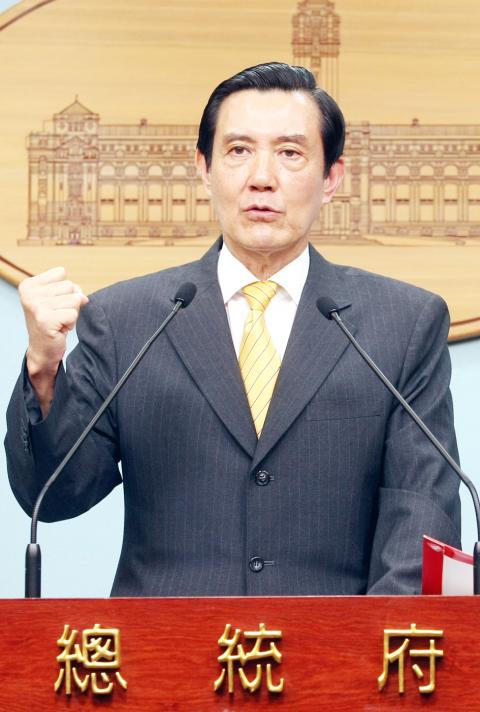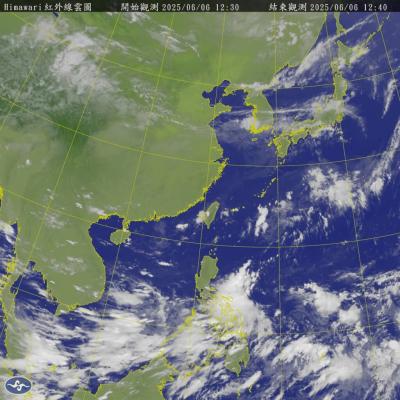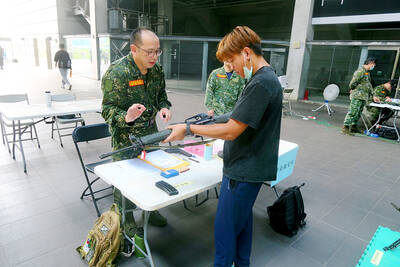President Ma Ying-jeou (馬英九) yesterday cited documents to defend the existence of the so-called “1992 consensus” and challenged Democratic Progressive Party (DPP) Chairperson Tsai Ing-wen’s (蔡英文) “Taiwan consensus,” urging her to offer a “clear” explanation of her presidential campaign platform.
In a hastily called press conference as Typhoon Nanmadol approached, Ma detailed the historical background of the “1992 consensus,” saying that it was reached in August 1992 during a meeting of the National Unification Commission and that “one China” refers to the Republic of China (ROC).
Its authority included all of China, but its current governing power was limited to Taiwan, Penghu, Kinmen and Matsu, he said.

Photo: CNA
Ma said former president Lee Teng-hui (李登輝) presided over the meeting in preparation for cross-strait negotiations between the Strait Exchange Foundation (SEF) and the Association for Relations Across the Taiwan Strait (ARATS) in October 1992 in Hong Kong.
Saying that he also participated in the meeting as Mainland Affairs Council vice chairman, Ma added that despite the fact that no concrete results were reached during negotiations, the SEF and ARATS agreed that each side could have its own interpretation of “one China.”
“This is how the two sides agreed to accept ‘one China, with each side having its own interpretation,’” Ma said.
“The term ‘1992 consensus’ was indeed added later [to describe the context], but ‘one China, with each side having its own interpretation’ did exist … It’s irrational to deny the truth,” he said.
Ma challenged Tsai’s cross-strait platform, urging her to clarify whether she supported the “three noes” and to explain “more clearly” what she means by “Taiwan consensus.”
The “three noes” refer to a policy proposed by Ma in 2008 — no pursuit of unification, no Taiwanese independence and no use of force in handling cross-strait relations.
Ma said what Tsai describes as a “Taiwan consensus” must be based on the desire of people in Taiwan and that the majority of Taiwanese supported maintaining the “status quo.”
“The desire of Taiwanese to maintain the ‘status quo’ is the most important basis for my ‘three noes’ policy, and I am hoping that Chairperson Tsai can tell us whether she supports the ‘three noes.’ Can she share her views on the ‘three noes’ policy? Especially, can she support the ‘no independence’ stance?” Ma said.
He challenged Tsai to explain whether Taiwan independence or calls for a name change to the ROC, as well as a new constitution, were behind her “Taiwan consensus.”
“The ROC is our country, and Taiwan is our home … This is a solid truth and there should be no hesitation or fear to love and support the ROC in running for the ROC presidency,” he said.
The DPP refused to respond to Ma’s challenge, accusing the president of playing politics at a time when the nation braced for a typhoon.
“Has President Ma lost his mind? … Calling a press conference on a day like this to explain what the so-called ‘1992 Consensus’ is?” DPP spokesman Chen Chi-mai (陳其邁) told the Taipei Times.
“Our hearts are with those who could be affected by the typhoon. The DPP is not going to call a press conference nor respond to anything unrelated to the typhoon today,” he said.
Ma showed “cold-bloodedness” in calling the press conference, when Nanmandol was approaching and torrential rain and strong winds had started to affect eastern Taiwan, DPP spokesman Chuang Ruei-hsiung (莊瑞雄) said in a press release.
“It appears that the ‘1992 Consensus’ and an opportunity to attack the opposition leader were more important to Ma than preparatory work for the typhoon,” he said. “The consensus of Taiwanese today is a consensus on disaster prevention, rather the ‘1992 Consensus.’”
Ma did not learn from Typhoon Morakot, the deadliest typhoon in Taiwan’s history, which killed more than 700 people in 2009, DPP spokesman Liang Wen-jie (梁文傑) said in the same press release.
Additional reporting by Chris Wang

STAY AWAY: An official said people should avoid disturbing snakes, as most do not actively attack humans, but would react defensively if threatened Taitung County authorities yesterday urged the public to stay vigilant and avoid disturbing snakes in the wild, following five reported snakebite cases in the county so far this year. Taitung County Fire Department secretary Lin Chien-cheng (林建誠) said two of the cases were in Donghe Township (東河) and involved the Taiwan habus, one person was bit by a Chinese pit viper near the South Link Railway and the remaining two were caused by unidentified snakes. He advised residents near fields to be cautious of snakes hiding in shady indoor areas, especially when entering or leaving their homes at night. In case of a

A tropical disturbance off the southeastern coast of the Philippines might become the first typhoon of the western Pacific typhoon season, the Central Weather Administration (CWA) said. The system lacks a visible center and how it would develop is only likely to become clear on Sunday or Monday, the CWA said, adding that it was not yet possible to forecast the potential typhoon's effect on Taiwan. The American Meteorological Society defines a tropical disturbance as a system made up of showers and thunderstorms that lasts for at least 24 hours and does not have closed wind circulation.

ENERGY RESILIENCE: Although Alaska is open for investments, Taiwan is sourcing its gas from the Middle East, and the sea routes carry risks, Ho Cheng-hui said US government officials’ high-profile reception of a Taiwanese representative at the Alaska Sustainable Energy Conference indicated the emergence of an Indo-Pacific energy resilience alliance, an academic said. Presidential Office Secretary-General Pan Men-an (潘孟安) attended the conference in Alaska on Thursday last week at the invitation of the US government. Pan visited oil and gas facilities with senior US officials, including US Secretary of the Interior Doug Burgum, US Secretary of Energy Chris Wright, Alaska Governor Mike Dunleavy and US Senator Daniel Sullivan. Pan attending the conference on behalf of President William Lai (賴清德) shows a significant elevation in diplomatic representation,

The Taipei City Reserve Command yesterday initiated its first-ever 14-day recall of some of the city’s civilian service reservists, who are to undergo additional training on top of refresher courses. The command said that it rented sites in Neihu District (內湖), including the Taipei Tennis Center, for the duration of the camp to optimize tactical positioning and accommodate the size of the battalion of reservists. A battalion is made up of four companies of more than 200 reservists each, it said. Aside from shooting drills at a range in New Taipei City’s Linkou District (林口), the remainder of the training would be at